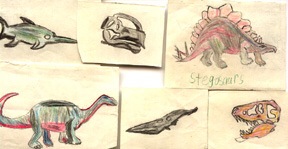
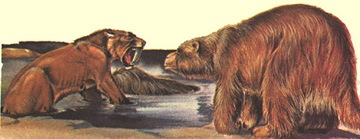
Spring vacation was a drive down to L.A. There were two things I really wanted to see. No, they weren't the Walk of Fame or the big sign or the stars' homes, but the Jet Propulsion Laboratory and the La Brea tarpits. These were two things which had fascinated me since childhood.
I still vividly remember the day, July 20, 1976, just a couple weeks after the Bicentennial, when the Viking I probe landed on Mars to look for life. I woke up as early as I could and flew down the stairs to the living room. I rushed to turn on the TV - 'cos I knew today was landing day, but I didn't know the time. I didn't want to miss a thing. I tuned in just as the very first images were broadcast from the sandy, rocky surface of Mars. It was a grainy black and white shot of the probe's round landing pad - its own foot! - on Martian soil. The image appeared strip by strip by strip as the data was beamed from millions of miles away and reassembled on Earth - at the Jet Propulsion Laboratory in Pasadena. Man, I wanted to go there! The JPL was where so many planetary probes were programmed and reprogrammed, where pictures of craters and the "face" on Mars were analyzed. Without Galileo and Voyager and the other space probes, all we had were fuzzy images of round blobs in space. With the probes, we had stunning close-ups of volcanos and (possibly) underwater oceans on the moons of Jupiter. JPL even had tours! But, alas, I called too late! We needed to reserve a month in advance. Rats! Foiled again! (The JPL story doesn't really have anything to do with the tarpits, but sometimes stories just need to be told, and this was the best context.)
But we did get to see the La Brea tarpits. Ever since I was little, I was fascinated by extinct creatures. In sixth grade, we had a Christmas grabbag. Everyone was supposed to bring a wrapped present, and they were all thrown into a big box. We each reached in and picked one. I got a deck of cards, and the teacher said, "That's great! You can play cards with your brother." But I was bummed - we already had cards at home. Some other kid was sitting not far from me, looking totally disappointed because all he got was "this dumb dinosaur book." We traded. The teacher said to me in the most disapproving tone, "Why'd you do that?" I wanted to tell her, Well, because dinosaurs are cool. She totally didn't understand.


Dino drawings I did in sixth grade; and illustration of saber-tooth and giant ground sloth at the La Brea tarpits - from The World of Prehistoric Life, ed. L. Plowden et al., 1971, Ottenheimer Publishers, Inc.: A book I had as a kid.
I still have that book. Over the years as I've gone to college and moved and salvaged things from my old house before my folks could throw them away - I always saved my old dinosaur books. A favorite was called Dinosaurs and Other Prehistoric Animals. I read and re-read the sections on dinosaurs, but it wasn't until later that I became interested in the "other prehistoric life." I had a bag of multi-colored prehistoric animals, and loved the red T. rex and the blue triceratops, but I never got into those weird, weird mammals and other post-dinosaur creatures: the gray giant flightless bird, the yellow saber tooth tiger, the green mastodon, the red glyptodont - like a sphere-shaped armadillo. Not until later did I grow to appreciate those guys: around the same time that I discovered trilobites and sea scorpions and ammonites and dragonflies with three-foot wingspans. I found that there was a whole lot more to the fossil record than just dinosaurs.
What I learned about the pits fascinated me. In most places the bones are just scattered about, broken-up pieces here and there. But the tarpits hold an amazing concentrated density of bones. In less than four cubic yards of asphalt dug from the pit, a paleontologist found 50 dire wolf skulls and 30 saber tooth skulls, plus remains of bison, horses, sloths, coyotes and birds! Not only that, but the fossils are incredibly well preserved - the detail is amazing. Unlike other fossils, the La Brea specimens are also not squashed and distorted by geological pressures.
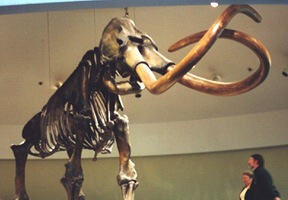
This is a 12-foot-tall skeleton of an adult imperial mammoth, the largest of the elephants that lived in North America. The museum has a very impressive array of mounted skeletons, including a couple saber tooth cats, a ground sloth, the mammoth shown here, and a blizzard of dire wolf skulls. (Dire wolves are like timber wolves but dumber.) You can also see fossil preparers at work and "test your strength" against tar goo. (Goo wins.) The museum is decorated with a wraparound bas-relief sculpture that illustrates these extinct animals, but badly needs cleaning.
There are no dinosaurs at the tar pit - because the pits were formed long after the dinosaurs were gone. There is, though, a nifty (if slightly defensive) little film they show explaining why there aren't any dinos there
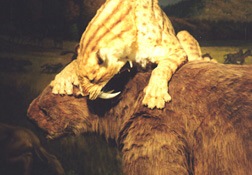
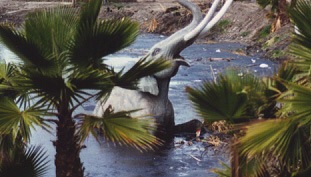
(L) Animatronics of saber-tooth v. ground sloth stuck in tarpit. Both lose. (R) Life-size statue sitting in the tarpit itself. The tarpits are still there, still capturing a bird or squirrel unawares. (They were doing all sorts of construction while we were there, but we could still see the prepared skeletons in the museum and see the tar pit through a fence.)
For more fotos related to the tarpits, click here.
La Brea tarpits and George C. Page Museum of La Brea Discoveries. 5801 Wilshire Boulevard, Los Angeles, Ca. 213-936-2230. Open Tues-Sun, 9:30-5 pm; closed Mon. Students with ID, $3.50; Adults, $6. Their homepage is here. The pits and the museum abutt the Los Angeles County Museum of Art. Across the street is a museum of miniatures and the Peterson Automotive Museum is around the corner. Site visited 3/99 and again, 11/01. Still very cool.
Back to Kitsch Tour U.S.A.
Back to Science Fiction Art
Back to Science Fiction and Humor Writing
Back to The Official Frank Wu Website homepage
Email to Frank Wu